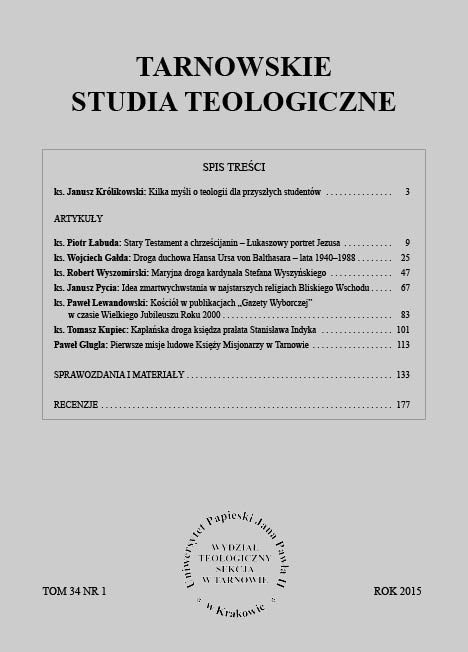The Church in the publications of „Gazeta Wyborcza” during the Great Jubilee of the Year 2000
DOI:
https://doi.org/10.15633/tst.1565Keywords:
„Gazeta Wyborcza”, the Church, the Great Jubilee of the Year 2000, instruments of social communicationAbstract
„Gazeta Wyborcza” is considered to be one of the most influential and opinion-generating Polish newspapers. Since its inception, it regularly publishes articles on topics closely related to the Church. During the Great Jubilee of the Year 2000 „Gazeta Wyborcza” published 677 texts on the Church, its pastoral leaders and faithful, texts broaching issues of ethics and Christian morality.
In the press material published in „Gazeta Wyborcza” in the Year of the Great Jubilee a vision of a divided and dissented Church, is clearly drawn. The journal editors recognize lack of internal unity among the clergy, as well as between the clergy and the faithful. The editors, while emphasizing the alleged internal division of the Church, point to the need for dialogue with liberal mentality. Hence, the journalists create in the daily paper symbols of this dialogue, which are promoted by them, the so called „soft faces” of the Church.
From the publications of „Gazeta Wyborcza” in the Year of the Great Jubilee a vision of the Church emerges as a kind of sociological and specific political formation. To define this, the journal editors usually use terms such as monarchy, fortress, stronghold, world power, headquarters, department or federation.
„Gazeta Wyborcza” is also known for its ingenuity in finding and vividly describing ecclesiastical sensations. Each revelation from the life of the Church and the people associated with it does not go unnoticed by the journalists and is reflected in numerous press reports, coverages and newspaper columns. It should be added that the „sensational” information often has no reflection in reality. Showing the scandals and sensationalism in the Church is an intentional activity and is designed to ridicule the clergy and to discourage the faithful in regard to the Church.
References
Artykuły zamieszczone w Gazecie Wyborczej z roku 2000 (konkretne dane w przypisach).
Braun J., Potęga czwartej władzy. Media, rynek, społeczeństwo, Warszawa 2005.
Filas R., Czytelnictwo prasy u progu Roku 2000, „Zeszyty Prasoznawcze” 43 (2000) nr 1–2, s. 206–222.
Grodzki R., Michnik Adam, [w:] Britannica. Edycja polska, red. W. Wolarski, t. 26, Poznań 2002, s. 294–296.
Grzybczak J., Społeczny klimat wokół polskich mediów w latach 1989–1999, „Zeszyty Prasoznawcze” 43 (2000) nr 3–4, s. 7–18.
Iłowiecki M., Krzywe zwierciadło. O manipulacji w mediach, Lublin 2003.
Iłowiecki M., Obraz chrześcijaństwa w mediach. Refleksje dziennikarza, [w:] Chrześcijaństwo jutra. Materiały II Międzynarodowego Kongresu Teologii Fundamentalnej, red. M. Rusecki i in., Lublin 2001, s. 95–121.
Iłowiecki M., Strażnicy, żeglarze i błazny. Autorytety i media, „Ethos” 10 (1997) nr 1 (37), s. 64–73.
Kozacki P., Wielka szansa dla Kościoła, „W Drodze” 1999 nr 9, s. 4–15.
Lepa A., Mity i obrazy, Łódź 1999.
Lepa A., Świat manipulacji, Częstochowa 1997.
Madera A. J., Fenomen „Gazety Wyborczej”, „Środkowoeuropejskie Studia Politologiczne” 2003 nr 1, s. 153–171.
Olędzki J., Kościół w polskich mediach, „Przegląd Powszechny” 122 (2005) nr 7–8, s. 165–173.
Pauluk D., Kościół katolicki na łamach „Gazety Wyborczej”, „Arcana” 1999 nr 1, s. 151–158.
Ratzinger J., Sól ziemi. Chrześcijaństwo i Kościół katolicki na przełomie tysiącleci. Z kardynałem Josephem Ratzingerem – Benedyktem XVI rozmawia Peter Seewald, Kraków 2005.
Skórzyński P., „Gazeta Wyborcza” – narodziny systemu władzy, „Arcana” 1997 nr 14 (2), s. 10–25.
Sonczyk W., Zmiany na rynku i ewolucja formuły wydawniczej prasy codziennej w Polsce 1990–2004. (Próba charakterystyki i oceny), „Studia Medioznawcze” 2005 nr 4, s. 11–25.
Stachowiak P., Dylematy zaangażowania. Kościół katolicki wobec wyborów parlamentarnych i prezydenckich w Polsce 1989–2001, „Przegląd Politologiczny” 8 (2003) nr 1, s. 75–88.
Ziemkiewicz R. A., Michnikowszczyzna. Zapis choroby, Lublin 2006.
Downloads
Published
Issue
Section
License
Authors who publish with this journal agree to the following terms:
- Authors retain the copyright and full publishing rights without restrictions, and grant the journal right of first publication with the work simultaneously licensed under a Creative Commons Attribution 4.0 International License that allows others to share the work with an acknowledgement of the work's authorship and initial publication in this journal.
- Authors are able to enter into separate, additional contractual arrangements for the non-exclusive distribution of the journal's published version of the work (e.g., post it to an institutional repository or publish it in a book), with an acknowledgement of its initial publication in this journal.
- Authors are permitted and encouraged to post their work online (e.g., in institutional repositories or on their website) prior to and during the submission process, as it can lead to productive exchanges, as well as earlier and greater citation of published work (See The Effect of Open Access).

